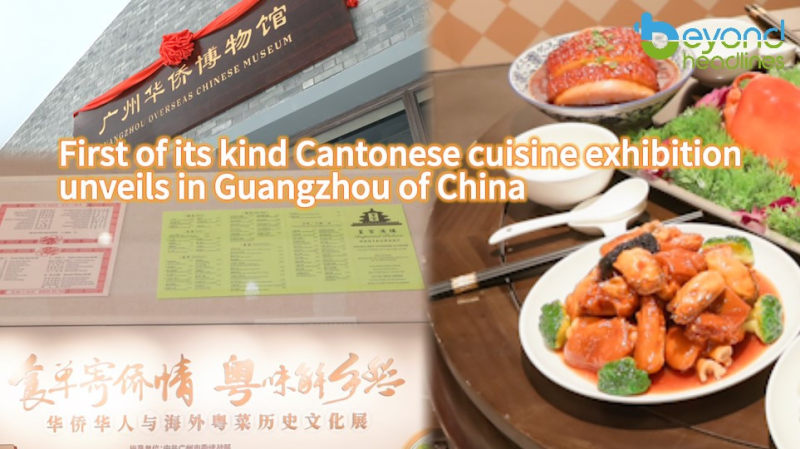V: Oh my legs are shaking. now I’m up here. Hello, how are you do-ing?
Operator: Hello!
B: When we were down below, we couldn’t tell that the field was so big. From up here we can see that it’s really huge!
In front of us is a vast expanse of white — a massive blanket of high-quality cotton. October is the peak season for cotton harvesting, so why aren’t there any farmers working in the fields? Instead, there are just a few machine operators operating a gigantic machine, trundling back and forth across the endless field. This is Awat County in Aksu of South Xinjiang, the home of the China’s long-time high-quality staple commodity: cotton.
Venus: As an environmentally conscious fashionista, I’m really con-cerned about the origins of the fibres and materials from which my clothes are made. Here in Xinjiang, it actually takes more than 87% of the cotton production in China, which is more than 20% in the whole world.
Burmie: All we can see it’s the shades of white. Nobody is here, just a machine over there.
Abulajiang Aisan, Farmers’ Co-op Manager
V: Hello!
B: How should I address you?
A: My name is Abulajiang.
V: So what do you do here?
A: Mechanized farming.
V: What is mechanized farming like?
A: Mechanized farming means that sowing, harvesting and pest management is all done by machines.
B: How big are your fields here?
A: 200 mu (a Chinese unit equivalent to more than half a square kil-ometer)
B: So how much can you earn each year?
A: The yield is 550 kg per mu
A: 8 RMB per kilogram, 550 (kg) per mu
Let me do a calculation. This field is 200 mu in its total area. With 550kg of cotton per mu, the total income would be 880,000 RMB. That means about RMB 1 million worth of cotton can be harvested in just half a day! All because of this cotton harvester, which is equivalent to the labor of nearly 500 workers!
B: How long does it take for your machine to harvest this
entire field?
A: My machine can generally harvest 300 meters per day, so it could finish this plot of land in half a day.
B: What about manual labor?
A: If it’s manual labor, one person can only harvest 8 mu. Finishing the whole field would take 2 months.
A: One person can only harvest 8 mu, no more.
V: I heard that the cotton is still harvested by hand here. Is this pos-sible?
A: Impossible. If it’s done by hand, the cost is about 2 RMB per kg, if I use a machine, the cost is 0.2 RMB per kg.
V: That’s a tenfold difference in operating cost.
With such high efficiency, it’s no wonder that machines like this are highly coveted in large scale agriculture. During the busy cotton harvesting season, about 6,500 machines like this one are operating on more than 37 million mu of cotton fields throughout Xinjiang. Let’s experience the power of the cotton harvester firsthand.
V: Let’s go!
The cotton harvester works efficiently and neatly, stripping cotton from the field row by row. The real magic happens inside this behe-moth where it removes leaves and twigs and automatically bundles the cotton bolls into a big round bale.
V: That’s the ‘golden egg’.
Every ten minutes it produces a 1.7-ton cotton roll which local peo-ple call it a ‘golden egg.’
The bountiful harvest of cotton that we can see today signifies that the manual labor farming mode has actually ended long ago. Throughout the 130-day growing period of cotton and especially at harvest time, a variety of modern and highly automated agricultural technologies are employed to make cotton farming a much more ef-ficient process for the farmers . Precision seeding, mulch covering, drip irrigation belt laying, pest control, fertilizing, harvesting and pro-cessing have all achieved a high degree of hands-free automation which exceeds 80%.
The seeder is also equipped with the Beidou satellite navigation au-tomatic driving system which ensures tidy rows of optimally spaced seedlings. Monitoring growth conditions and spraying is handled by drones. Cotton farmers can use their mobile phones to remotely control drones to accurately manage pests. An automated drone system for pest control reduces the overall quantity to 20% which is the most environmentally sound method and preserves the soil health for future generations of cotton farmers.
According to the latest figures from November 2023, the ‘mechani-zation rate of seeding and farming’ and ‘machine harvesting rate’ in the Aksu region of Xinjiang, including Awat County, are both over 90%.
B:I am really stunned by this experience. We have heard a lot about Xinjiang. If only you are here, you will know the actual situa-tion.
V:And we can also experience the power of science and technolo-gy, it only takes a few minutes to collect 1.7 tons of cotton behind us, which is impossible to be achieved through manual labor. So only by being here, you will know how it really works.
Abulajiang’s Farmers’ Co-op is composed of small cotton fields of many other farmers. To make it possible to apply agricultural tech-nology, mechanization, digitization, and the use of large machinery for farming and harvesting cotton, a large area of cotton fields is needed to achieve the best economic benefits. He needs to con-vince the farmers nearby to pool their land resources together for management by him. It’s not an easy task to change farmers’ men-tality and reliance on the cotton fields as the fields have long been their lifeline. Abulajiang himself was determined to lead the change and set an example for other 240 farmers who later joined hands with him in running the Farmers’ Co-op.
B: How long have you started the mechanization?
A: I started using machines in 2018. I learned by myself first and asked others to observe how it worked. In the beginning, I talked to them and explained the merits of pooling our resources together. Say, there are four people in your family, crawling in the field for a year, isn’t it hard? Instead, I consistently pay you 1,000 RMB for each mu of your land and you have the freedom to start a second career. In a good season, we will even pay out dividends.
V:We are now in a local village, with the launch of farmers’ Co-op, they are able to realize land circulation and be able to have more time and room to enjoy life, and also develop their second business.
This villager’s land is contracted by the Farmers’ Co-op of Abula-jiang, so now he doesn’t have to work arduously under the burning sun in the cotton fields for long hours every day. Life to him now has an abundance of choices. He developed “agritainment” at home, decorating his house with the red and yellow color. Paired with tall grape racks, as soon as you walk in, you will be attracted by the unique Uyghur characteristics.
Abulizi Awuti, Cotton Farmer
Gulihumaer Maihemuti, Translator
Translator: There is the Doulang Tribe Scenic Area nearby, and there is also a large ‘agritainment’ site across from his house. He realized that there were many tourists visiting the area so he took this opportunity to develop his small courtyard into a modest ‘agritainment’ restaurant.
B: Has the income from the farmland decreased as compared to that of the past?
Translator: There are no cuts in his income. After the land is trans-ferred, the Farmers’ Co-op continuously gives them a share of the money. Translator: By opening a small ‘agritainment’ restaurant at his house, he has added a substantial secondary source of income.
Abulizi is a farmer. But the life for this next generation is completely different. Since 2000s, automation and mechanization of cotton farming and harvesting has been realized in Xinjiang. Abulizi’s kids have been and will continue to benefit from this historic change. Among his three children, one has become a doctor, one a teacher, and another is studying at a university in Chongqing. Their children no longer need to continue the strenuous work of their predecessors in cotton fields. With stable household income, they can receive better education.
Although he no longer has to work hard in the fields, Abulizi
still keeps a small piece of land in his backyard to grow vegetables and fruits. He can also sell the produce to other nearby restaurants, further increasing his income.
Translator:
He said he would plant peppers, eggplants, tomatoes, and more. This way, he can cook these home-grown vegetables and won’t need to buy them from elsewhere.
Seeing Abulizi holding his adorable grandson in his arms and shar-ing with us the contrast between his past and present livelihood, we can see the reflection of any family from any background. Regard-less of where we come from, we all just want a better life for our families while also having time to enjoy that life. This is the balance that we all eventually strive for, and it’s no different here in the rolling fields of far-off Xinjiang.
Despite all the rumors about cotton planting and picking on the in-ternet, anyone who has been here will quickly realize that revolu-tionary changes have been brought about by modern agricultural technologies — exponentially improving the lives of the local people. While local people spare no effort in striving for better life, with the ‘golden eggs’, they now have more choices in how to curate that life with comfort and joy, especially for the next generation who have the freedom to choose their path as the mega-machines work wordlessly in the fields nearby.












